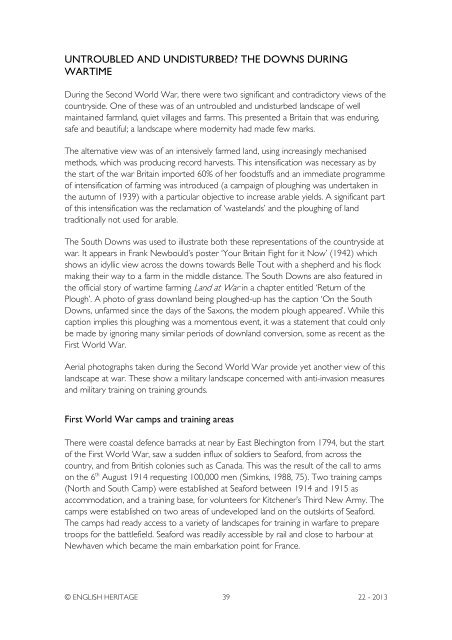Aerial Investigation and Mapping Report - English Heritage
Aerial Investigation and Mapping Report - English Heritage
Aerial Investigation and Mapping Report - English Heritage
You also want an ePaper? Increase the reach of your titles
YUMPU automatically turns print PDFs into web optimized ePapers that Google loves.
UNTROUBLED AND UNDISTURBED? THE DOWNS DURINGWARTIMEDuring the Second World War, there were two significant <strong>and</strong> contradictory views of thecountryside. One of these was of an untroubled <strong>and</strong> undisturbed l<strong>and</strong>scape of wellmaintained farml<strong>and</strong>, quiet villages <strong>and</strong> farms. This presented a Britain that was enduring,safe <strong>and</strong> beautiful; a l<strong>and</strong>scape where modernity had made few marks.The alternative view was of an intensively farmed l<strong>and</strong>, using increasingly mechanisedmethods, which was producing record harvests. This intensification was necessary as bythe start of the war Britain imported 60% of her foodstuffs <strong>and</strong> an immediate programmeof intensification of farming was introduced (a campaign of ploughing was undertaken inthe autumn of 1939) with a particular objective to increase arable yields. A significant partof this intensification was the reclamation of ‘wastel<strong>and</strong>s’ <strong>and</strong> the ploughing of l<strong>and</strong>traditionally not used for arable.The South Downs was used to illustrate both these representations of the countryside atwar. It appears in Frank Newbould’s poster ‘Your Britain Fight for it Now’ (1942) whichshows an idyllic view across the downs towards Belle Tout with a shepherd <strong>and</strong> his flockmaking their way to a farm in the middle distance. The South Downs are also featured inthe official story of wartime farming L<strong>and</strong> at War in a chapter entitled ‘Return of thePlough’. A photo of grass downl<strong>and</strong> being ploughed-up has the caption ‘On the SouthDowns, unfarmed since the days of the Saxons, the modern plough appeared’. While thiscaption implies this ploughing was a momentous event, it was a statement that could onlybe made by ignoring many similar periods of downl<strong>and</strong> conversion, some as recent as theFirst World War.<strong>Aerial</strong> photographs taken during the Second World War provide yet another view of thisl<strong>and</strong>scape at war. These show a military l<strong>and</strong>scape concerned with anti-invasion measures<strong>and</strong> military training on training grounds.First World War camps <strong>and</strong> training areasThere were coastal defence barracks at near by East Blechington from 1794, but the startof the First World War, saw a sudden influx of soldiers to Seaford, from across thecountry, <strong>and</strong> from British colonies such as Canada. This was the result of the call to armson the 6 th August 1914 requesting 100,000 men (Simkins, 1988, 75). Two training camps(North <strong>and</strong> South Camp) were established at Seaford between 1914 <strong>and</strong> 1915 asaccommodation, <strong>and</strong> a training base, for volunteers for Kitchener’s Third New Army. Thecamps were established on two areas of undeveloped l<strong>and</strong> on the outskirts of Seaford.The camps had ready access to a variety of l<strong>and</strong>scapes for training in warfare to preparetroops for the battlefield. Seaford was readily accessible by rail <strong>and</strong> close to harbour atNewhaven which became the main embarkation point for France.© ENGLISH HERITAGE 39 22 - 2013

















